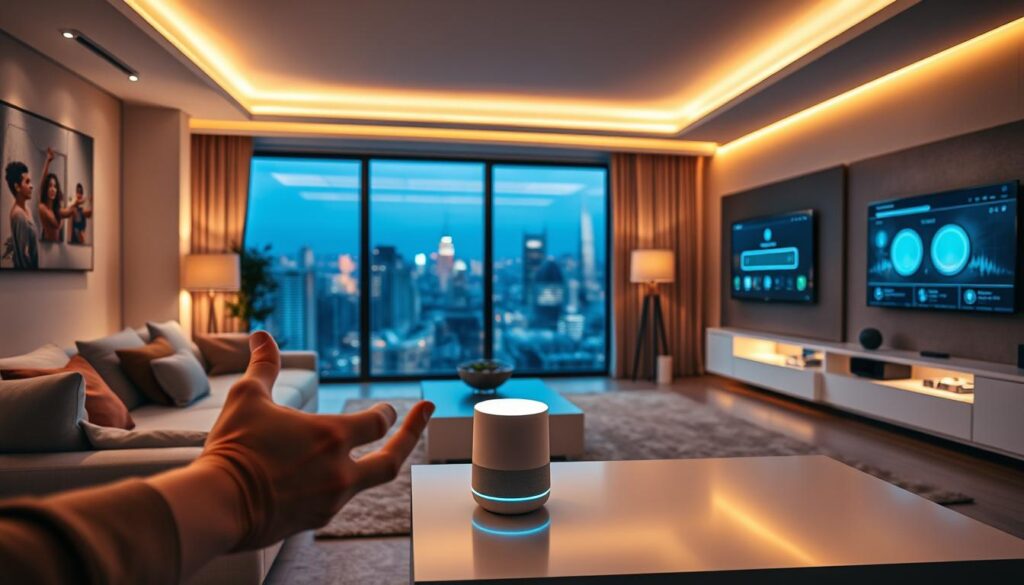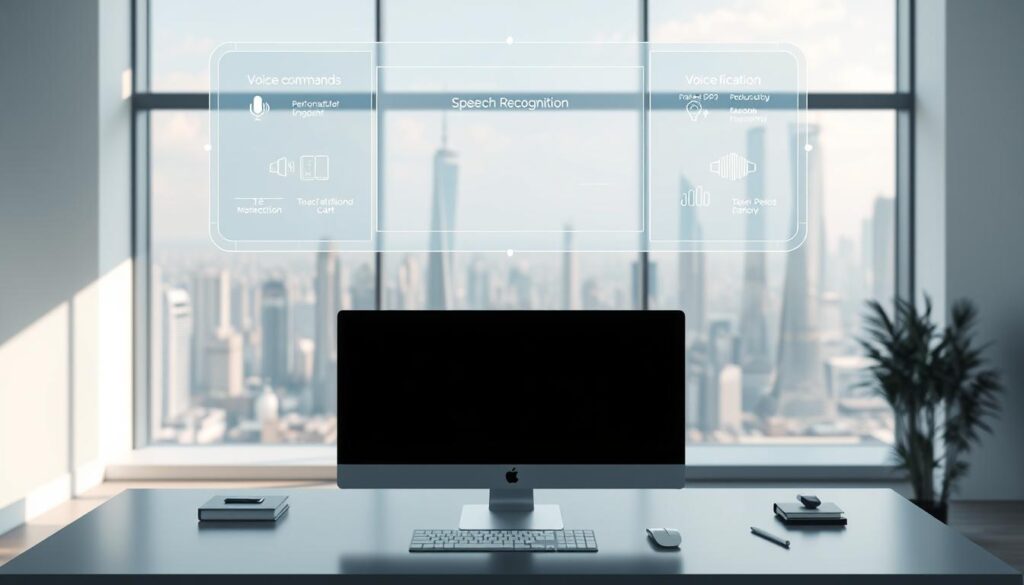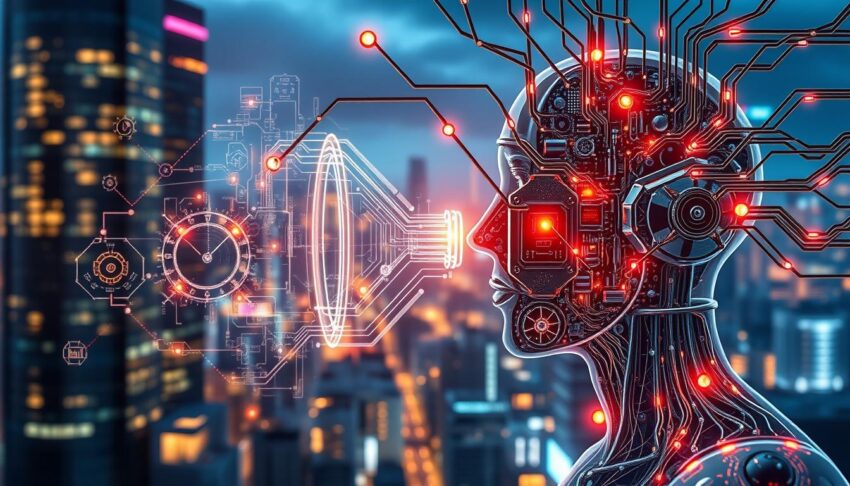How is speech recognition changing how we talk to machines and each other? It's not just a dream anymore. It's a key part of today's tech world. Knowing about the latest in voice recognition can help both businesses and people.
Big names like Google and Amazon are putting a lot into this tech. This shows how big the future of digital dictation is. We'll look at how these changes are making our talks with machines better and more automatic.
Get ready to learn about speech recognition's growth, current trends, and what's coming next.
Key Takeaways
- Speech recognition technology is rapidly evolving, impacting various industries.
- Voice recognition software enhances user experience by improving accessibility.
- Digital dictation tools are becoming essential for productivity and efficiency.
- Leading companies are investing in innovations for advanced speech recognition.
- The integration of AI is crucial for the future of speech recognition applications.
The Evolution of Speech Recognition Technology
The journey of speech recognition technology shows big steps in understanding language and computers. It started in the 1950s, beginning our voice recognition history. Early systems tried to copy simple sounds, but they had many problems.
Over time, big changes made today's smart systems like Amazon's Alexa and Microsoft's Cortana possible.
A Brief History of Voice Recognition
In the 1960s, IBM created a big step with its Shoebox machine. It could understand 16 words. This was a key moment in voice tech, leading to more progress.
The 1990s brought more growth with Dragon NaturallySpeaking and Aurora. These let people control computers with their voice. This opened new uses for these technologies.
Key Milestones in Speech Recognition Development
Important moments have made speech recognition better. For example, Hidden Markov Models in the 1980s made systems more accurate. Then, in the 2000s, machine learning made things even better.
Today, AI is making these technologies even smarter. It's changing what they can do.
Current Trends in Speech Recognition
Technology is changing fast, and speech recognition is no exception. We're seeing better accuracy and more people using it every day. It's getting better at fitting into our lives.
Experts think this area will keep growing. They say it's because of new things in artificial intelligence and machine learning.
Market Insights and Growth Predictions
A recent study shows the speech recognition market is growing fast. IDC says it will keep getting bigger. This is because more people want smart devices and voice apps.
These apps are becoming popular in healthcare, cars, and gadgets we use at home.
| Year | Market Value (in billion $) | Growth Rate (%) |
|---|---|---|
| 2023 | 12.2 | 18% |
| 2024 | 14.5 | 19% |
| 2025 | 17.2 | 20% |
Integration with AI and Machine Learning
AI is making speech recognition systems smarter. It makes them faster and more accurate. This leads to better user interfaces.
Google and Microsoft are using advanced tech to make their voice assistants better. This makes talking to them feel more natural.
AI and speech recognition are coming together in new ways. This is helping businesses serve their customers better. It's also making things more efficient.
As these technologies get even better, we'll see voice interaction everywhere. It will make our lives easier and more enjoyable.
Speech Recognition and Natural Language Processing
Speech recognition and natural language processing (NLP) are key in today's tech. They help make talking to machines better. This lets apps understand what we mean, making talking to them easier.
How NLP Enhances User Engagement
NLP makes talking to machines feel more natural. It gets the meaning behind our words, including feelings. This means apps can give us what we really want, right when we want it.
- Improved response accuracy
- Context-aware dialogue systems
- Enhanced accessibility for users with disabilities
Thanks to NLP, our talks with machines are more meaningful. We feel like they really get us. This makes digital apps more special.
Challenges in Language Understanding
Even with progress, there are still big challenges. Different ways of speaking and saying things can confuse machines. This makes it hard for them to always get it right.
Here's a table showing some big challenges and how to solve them:
| Challenges | Potential Solutions |
|---|---|
| Diverse Accents | Expanded training datasets reflecting various accents |
| Contextual Misunderstandings | Enhanced algorithms for contextual analysis |
| Linguistic Nuances | Continuous refinement of NLP models |
Fixing these problems is key for NLP to keep getting better. It's all about making our talks with machines even better.
Voice Command Technology in Everyday Life
Voice command technology has changed how we live. It lets us control our homes with our voices. This is thanks to smart home apps and voice assistants like Amazon Alexa and Google Assistant.
Smart Home Applications
Smart home apps make life easier. They let us control lights, thermostats, and security with our voices. Here are some cool apps:
- Smart lighting systems let us change light colors with our voices.
- Smart thermostats make it easy to set the temperature.
- Security systems let us lock doors and check our homes with voice commands.
Voice Assistants and Their Growing Popularity
Voice assistants are getting more popular. They work with many devices to make our homes smarter. People love how easy it is to use them without touching anything.
| Voice Assistant | Market Share (%) | Monthly Active Users (Millions) |
|---|---|---|
| Amazon Alexa | 40 | 100 |
| Google Assistant | 30 | 80 |
| Siri | 20 | 60 |
| Other Assistants | 10 | 25 |
These numbers show how much people like these systems. They make controlling our homes easy and convenient. It fits perfectly with how we live today.

Impact of Automated Speech Recognition on Businesses
Automated speech recognition has changed how businesses work. It helps make things more efficient, especially in customer service. By using voice recognition, companies can make things faster and happier for customers.
Efficiency Gains in Customer Service
Many businesses have seen big improvements in customer service. They can answer questions quickly without needing people. This means they can use their time better.
For example, Zappos now handles calls faster. American Express also sees better service, keeping more customers happy.
Case Studies of Successful Implementations
There are many examples of how automated speech recognition works well. Companies like McKinsey & Company say it makes things smoother and clearer. Here are a few examples:
| Company | Implementation Results | Efficiency Improvement |
|---|---|---|
| Zappos | Reduced call handling time | 30% faster |
| American Express | Improved customer retention rates | 20% increase |
| Bank of America | Enhanced customer query resolution | 25% more efficient |
Applications of Voice-to-Text Technology
Voice-to-text technology has changed many areas, like healthcare and law. It makes work faster and more accurate. Now, it's used a lot in healthcare and law for writing things down.
It's also a big help in business tools. These tools make work easier and faster for companies.
Use Cases in Healthcare and Legal Industries
In healthcare, voice-to-text tech has changed how doctors write notes. Doctors use it to write down patient info, prescriptions, and reports. This saves a lot of time.
Doctors can then spend more time with patients. This makes patient care better.
In law, Westlaw uses voice-to-text for court records and transcripts. Lawyers can quickly write down important points. This helps them prepare for cases better.
It makes their work easier and helps them serve clients better.
Productivity Tools for Businesses
Many business tools now use voice-to-text. Otter.ai and Google Docs voice typing let teams work together better. They turn spoken words into text right away.
This makes talking and writing faster. It also makes sure meetings are well recorded.
Using voice-to-text in these tools helps employees do their jobs better. This makes the whole team more productive.
| Industry | Application | Benefit |
|---|---|---|
| Healthcare | Medical Dictation | Improved patient documentation speed |
| Legal | Transcription of Legal Documents | Enhanced accuracy and time savings |
| Business | Collaborative Documentation Tools | Increased workplace efficiency |
Advancements in Speech-to-Text Software
New speech-to-text tech is changing how we write and talk. Neural networks help make it more accurate and fast. This makes writing down what we say easier and faster for work.
Improved Accuracy and Speed
Today's speech-to-text software is much better than before. It makes fewer mistakes than old systems. Companies like Otter.ai and Google Cloud Speech-to-Text make sure it's mostly right.
These tools also work faster. They can write down what we say almost right away. This makes using them very smooth.
Real-time Transcription Features
Real-time transcription has changed how we record meetings and events. It lets users see text right away as people talk. This makes meetings more lively and interactive.
It also helps everyone understand each other better. With these new tech advancements, writing down what we say is easier than ever.
Future of Digital Dictation and Speech Recognition
The world of digital dictation and speech recognition is changing fast. New tech, like neural processing and advanced speech synthesis, will make things better. These changes will make voice apps more accurate and efficient, helping many areas.
Emerging Technologies and Innovations
New speech recognition tech is coming, and it will change how we use it. Artificial intelligence and machine learning will make systems smarter. They will learn what we like and do better over time.
Natural language processing will make talking to computers easier. Soon, using digital dictation will be a breeze. It will make our work and daily tasks better and faster.
Predictions for User Adoption and Market Trends
Experts think more people will start using digital dictation soon. Healthcare and legal fields will see a big increase in demand. As tech gets better, more people will use it.
Markets are showing a big interest in speech recognition tech. This means more money will go into making it better. It will become a key part of work, helping companies stay ahead.

Challenges Facing Speech Recognition Developers
The world of speech recognition is always getting better. But, there are still big challenges. Developers work hard to make it more accurate and easy to use for everyone. They face two big problems: dealing with different accents and dialects, and handling background noise.
Fixing these issues is key to making the technology better. It will help more people use it and make it work for different groups.
Addressing Accents and Dialects
One big challenge is dealing with all the different accents and dialects around the world. Systems need to learn to recognize how people speak in different ways. Companies like Microsoft and IBM are working hard on this.
They use big datasets with lots of different ways of speaking. This helps their systems get better at understanding different voices.
Coping with Background Noise
Background noise is another big problem. When there are lots of sounds around, it can make it hard for systems to understand what's being said. But, there are new ways to deal with this.
Devices can now filter out unwanted sounds. This makes it easier to hear what's important. Developers are also using new tech to make systems work better in noisy places.
| Challenge | Description | Potential Solutions |
|---|---|---|
| Handling Accents | Diverse pronunciations across regions and cultures. | Data enrichment with varied linguistic inputs; adaptive training. |
| Background Noise Issues | Competing sounds that hinder recognition accuracy. | Noise-cancellation technology; adaptive machine learning algorithms. |
Conclusion
The journey of speech recognition has shown us amazing progress. It has grown from simple beginnings to today's advanced AI. This technology is changing many areas of life.
It has made our daily tech use better. It also makes things more efficient and fun. This is good for work and play.
Speech recognition works well with AI and natural language. This makes using technology easier and more fun. Businesses are using it to get better at what they do.
It's important for everyone to keep up with these changes. Knowing about these tech advancements helps us stay ahead. It's key for both people and tech experts.
Speech technology is always getting better. We need to keep learning about it. This will help us understand and use it better.
As we learn more, we can lead in new tech. Those who get it will be at the forefront of change.
